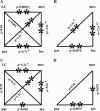Cis-effects on meiotic recombination across distinct a1-sh2 intervals in a common Zea genetic background
- PMID: 15937141
- PMCID: PMC1449771
- DOI: 10.1534/genetics.104.034454
Cis-effects on meiotic recombination across distinct a1-sh2 intervals in a common Zea genetic background
Abstract
Genetic distances across the a1-sh2 interval varied threefold in three near-isogenic stocks that carry structurally distinct teosinte A1 Sh2 haplotypes (from Z. mays spp. mexicana Chalco, Z. mays spp. parviglumis, and Z. luxurians) and a common maize a1::rdt sh2 haplotype. In each haplotype >85% of recombination events resolved in the proximal 10% of the approximately 130-kb a1-sh2 interval. Even so, significant differences in the distributions of recombination breakpoints were observed across subintervals among haplotypes. Each of the three previously detected recombination hot spots was detected in at least one of the three teosinte haplotypes and two of these hot spots were not detected in at least one teosinte haplotype. Moreover, novel hot spots were detected in two teosinte haplotypes. Due to the near-isogenic nature of the three stocks, the observed variation in the distribution of recombination events is the consequence of cis-modifications. Although generally negatively correlated with rates of recombination per megabase, levels of sequence polymorphisms do not fully account for the nonrandom distribution of recombination breakpoints. This study also suggests that estimates of linkage disequilibrium must be interpreted with caution when considering whether a gene has been under selection.
Figures





References
-
- Allers, T., and M. Lichten, 2001. Differential timing and control of noncrossover and crossover recombination during meiosis. Cell 106: 47–57. - PubMed
-
- Arumuganathan, K., and E. D. Earle, 1991. Nuclear DNA content of some important plant species. Plant Mol. Biol. Rep. 9: 208–218.
-
- Borts, R. H., S. R. Chambers and M. F. Abdullah, 2000. The many faces of mismatch repair in meiosis. Mutat. Res. 451: 129–150. - PubMed
-
- Brown, J. J., G. Mattes, C. O'Reilly and N. S. Shepherd, 1989. Molecular characterization of rDt, a maize transposon of the “Dotted” controlling element system. Mol. Gen. Genet. 215: 239–244. - PubMed
Publication types
MeSH terms
Substances
Associated data
- Actions
- Actions
- Actions
- Actions
- Actions
- Actions
- Actions
LinkOut - more resources
Full Text Sources
Miscellaneous

